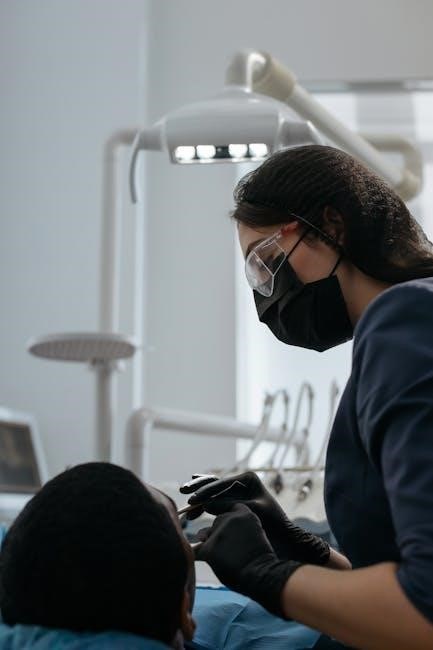This comprehensive guide provides essential knowledge for dental assistants‚ covering key terminology‚ procedures‚ and clinical skills. It includes free resources and tips for exam preparation‚ ensuring success in the field.
Overview of the Dental Assistant Role
A dental assistant plays a vital role in ensuring efficient dental office operations. Their responsibilities include preparing patients for exams‚ maintaining records‚ and assisting during procedures. They handle tasks like taking radiographs‚ impressions‚ and applying sealants. Dental assistants must have strong communication skills to reassure patients and explain treatments. They also manage infection control and sterilization of instruments‚ ensuring a safe environment. The role requires both clinical and administrative skills‚ making dental assistants indispensable to the dental team. This study guide provides detailed insights into the duties and expectations‚ helping aspiring dental assistants master their responsibilities and excel in their careers. It serves as a valuable resource for understanding the multifaceted nature of the role and preparing for real-world challenges.
Importance of a Study Guide for Dental Assistants
Importance of a Study Guide for Dental Assistants
A study guide is an essential tool for dental assistants‚ providing structured learning materials to master key concepts and skills. It organizes complex information into digestible sections‚ covering dental terminology‚ procedures‚ and clinical practices. By using a study guide‚ dental assistants can prepare effectively for certification exams‚ such as the Certified Dental Assistant (CDA) exam‚ and gain confidence in their abilities. The guide also includes practice test questions‚ helping to identify areas for improvement. Additionally‚ it serves as a reliable reference for understanding patient care protocols‚ instrument handling‚ and safety measures. A well-prepared study guide ensures that dental assistants are equipped with the knowledge and skills needed to excel in their roles and deliver high-quality patient care.
Benefits of Using a Free PDF Study Guide
Benefits of Using a Free PDF Study Guide
Utilizing a free PDF study guide offers numerous advantages for dental assistants. It provides accessible‚ cost-effective learning materials that can be downloaded and reviewed anywhere. Free PDF guides often include comprehensive content‚ such as dental terminology‚ clinical procedures‚ and exam preparation tips. They are ideal for self-paced learning‚ allowing individuals to study at their convenience. Many free PDF guides are updated regularly to reflect current practices and standards in dentistry. Additionally‚ they often include interactive elements‚ such as practice test questions and study tips‚ to enhance understanding and retention. This resource is particularly beneficial for those preparing for certification exams or seeking to refresh their knowledge in specific areas. It’s a valuable tool for continuous learning and professional development in the dental assisting field.

Dental Terminology and Basics
Mastering dental terminology and basics is essential for assistants. Key terms‚ tooth charts‚ and foundational concepts ensure clear communication and effective clinical tasks in daily practice.
Key Dental Terms Every Assistant Should Know
Understanding key dental terms is crucial for effective communication. Terms like distal‚ mesial‚ and occlusal describe tooth surfaces. Primary teeth refer to baby teeth‚ while permanent teeth are adult teeth. Enamel‚ dentin‚ and pulp are tooth structures. Gingiva is gum tissue‚ and periodontal relates to supporting structures. Caries is tooth decay‚ and restoration refers to fillings. Implant and prosthetics are common procedures. Familiarity with these terms aids in patient care‚ documentation‚ and procedure assistance. Free PDF guides provide detailed lists and definitions‚ ensuring assistants grasp these essentials for accurate communication and efficient workflow in dental practices.
Understanding Dental Anatomy
Mastering dental anatomy is fundamental for dental assistants. The tooth structure includes the crown (visible part)‚ neck (narrowing below the crown)‚ and root (embedded in the jaw). Surrounding tissues like gingiva (gums) and periodontal ligaments (anchoring teeth) are vital. Teeth are classified into incisors‚ canines‚ premolars‚ and molars‚ each with specific functions. Understanding these structures aids in identifying issues and assisting in procedures. Free PDF guides often include detailed diagrams and 3D models to enhance comprehension. Familiarity with dental anatomy ensures accurate communication and effective patient care‚ making it a cornerstone of dental assistant training and practice.
Common Dental Procedures and Terminology
Familiarity with common dental procedures and terminology is essential for dental assistants. Procedures like fillings‚ extractions‚ and crowns are frequently performed. Terms such as molar‚ incisor‚ and impression are regularly used. Understanding these concepts ensures clear communication between staff and patients. Free PDF guides often detail these procedures‚ aiding in study and practical application. Terms like prophylaxis (cleaning) and orthodontic treatments (braces) are also key. Mastery of this terminology enhances efficiency in patient care and procedure documentation. Free resources provide comprehensive lists and explanations‚ making learning accessible and effective for aspiring dental assistants.

Clinical Procedures and Skills
Mastering clinical procedures is vital for dental assistants. This section covers impression handling techniques and infection control protocols‚ ensuring patient safety and successful procedural outcomes.
Preparation for Patient Care
Preparation for patient care is a critical step in dental assisting. It involves greeting patients‚ reviewing medical histories‚ and ensuring all necessary equipment is sterilized and ready. Dental assistants must also prepare impression materials and ensure proper infection control measures are in place. This includes setting up dental trays‚ suction devices‚ and anesthesia equipment if needed. Proper patient positioning and draping are essential to maintain comfort and hygiene. Additionally‚ assistants should prepare protective gear such as gloves and masks for both the patient and dental team. Effective preparation ensures smooth procedures‚ builds patient trust‚ and adheres to safety protocols. This step is vital for efficient and safe dental care delivery.
Instrument Handling and Sterilization Techniques
Proper instrument handling and sterilization are essential for maintaining a safe and hygienic dental environment; Dental assistants must learn to identify‚ use‚ and care for various instruments‚ ensuring they are always sterile before use. Autoclaving is a common method for sterilizing instruments‚ while chemical disinfectants are used for surfaces. Assistants should handle instruments carefully to avoid damage and contamination. Impressions and materials must be mixed and loaded smoothly‚ free of air bubbles‚ to ensure accuracy. Sterilization protocols‚ including proper packaging and tracking‚ are critical to prevent cross-infection. Regular training and adherence to safety guidelines help maintain high standards of patient care and infection control in dental practices.
Assisting in Various Dental Procedures
Dental assistants play a crucial role in supporting dentists during diverse procedures‚ such as fillings‚ extractions‚ and crowns. They must maintain asepsis‚ handle instruments precisely‚ and ensure patient comfort. Assistants are often responsible for suction control during procedures‚ retracting tissues‚ and mixing materials like impression compounds. Proper handling of impression trays and materials ensures accurate dental models. In orthodontic procedures‚ assistants may help with bracket placement and archwire adjustments. Effective communication with both the dentist and patient is vital to streamline workflows. Staying alert and anticipating the dentist’s needs enhances efficiency. Free study guides provide detailed insights into these tasks‚ helping assistants master their roles in various clinical scenarios and improve overall patient care outcomes. Continuous practice and adherence to protocols are essential for success.

Dental Materials and Impression Techniques

Understanding various dental materials‚ such as alginate and silicone‚ is crucial for impressions. Proper mixing‚ handling‚ and loading techniques ensure accurate models‚ aiding in precise dental treatments and patient care.
Types of Dental Materials Used in Practices
Dental practices utilize a variety of materials to ensure effective patient care. Impression materials‚ such as alginate and silicone‚ are used for creating accurate dental models. Restorative materials like amalgam and composite resins are employed for fillings. Additionally‚ dental cements and impression trays are essential for procedures. Each material has specific properties and applications‚ making them vital for different treatments. Understanding these materials is crucial for dental assistants to support procedures efficiently and safely. Proper handling and storage are also key to maintaining their effectiveness. This section provides a detailed overview of the materials commonly used‚ helping dental assistants grasp their roles in modern dentistry.
Proper Mixing and Handling of Impression Materials
Proper mixing and handling of impression materials are critical for accurate dental impressions. The material should be mixed until smooth and glossy‚ avoiding air bubbles. Loading impression trays requires careful measurement to ensure adequate coverage without overflow. Impressions must be removed gently after setting to prevent distortion. Using distilled water for mixing certain materials ensures optimal results. Proper handling minimizes errors and ensures patient comfort‚ making it essential for dental assistants to master these techniques. This section provides step-by-step guidance on mixing and handling impression materials effectively‚ adhering to best practices in dental care.
Best Practices for Loading and Unloading Impressions
When loading impressions‚ ensure the tray is filled evenly‚ covering all necessary areas without overflowing. Use a spatula to smoothly spread the material‚ avoiding air bubbles. For mandibular trays‚ divide the material evenly between both sides. After setting‚ remove impressions gently to prevent distortion. Store them in a sealed bag to maintain humidity and prevent deformation. Proper handling ensures accurate dental models. Following these steps minimizes errors and enhances patient care. This guide offers detailed instructions on loading and unloading impressions‚ helping dental assistants achieve precise results consistently.

Pharmacology and Physiology
Pharmacology involves studying drug actions and interactions‚ crucial for dental assistants to manage medications safely. Physiology focuses on bodily functions‚ aiding in understanding patient responses and optimizing care.
Basic Pharmacology for Dental Assistants
Understanding pharmacology is vital for dental assistants‚ as it involves the study of drugs and their effects on the body. This knowledge helps in managing medications safely‚ including anesthetics‚ analgesics‚ and antibiotics commonly used in dental procedures. Dental assistants must recognize drug interactions‚ allergies‚ and side effects to ensure patient safety. Familiarity with pharmacological terms and classifications is essential for proper communication with dentists and other healthcare professionals. Additionally‚ understanding how drugs interact with systemic conditions‚ such as diabetes or hypertension‚ is crucial for providing personalized care. This section covers the fundamentals of pharmacology‚ emphasizing practical applications in dentistry to enhance clinical decision-making and patient outcomes.

Understanding Physiology Relevant to Dentistry
Understanding physiology is crucial for dental assistants‚ as it provides insight into the body’s functions and how they relate to oral health. This knowledge helps in recognizing how systemic conditions‚ such as diabetes or hypertension‚ can impact dental care. Key areas include the nervous‚ cardiovascular‚ and respiratory systems‚ which play roles in pain perception‚ bleeding control‚ and patient anxiety. Additionally‚ understanding the digestive system aids in addressing issues like enamel erosion from acid reflux. Familiarity with physiological responses‚ such as inflammation and healing‚ is essential for supporting patient recovery. This section emphasizes practical applications of physiological principles in dentistry‚ ensuring safe and effective care.
Drug Interactions and Allergies in Dental Care
Understanding drug interactions and allergies is vital for dental assistants to ensure patient safety. Certain medications‚ such as antibiotics‚ analgesics‚ and anesthetics‚ can interact with dental treatments‚ leading to complications. For example‚ blood thinners may increase bleeding risks during procedures. Additionally‚ patients may have allergies to materials like latex or lidocaine‚ requiring careful screening. Dental assistants must communicate effectively with patients to identify potential allergies and review medical histories. Proper documentation and consultation with dentists are critical to avoid adverse reactions; This section highlights common interactions and allergens‚ emphasizing the importance of vigilance and proactive care to prevent emergencies. Free study guides often include charts and lists to help identify and manage these risks effectively.

Dental Radiography and Safety
Dental radiography involves capturing images of teeth and surrounding structures. Safety protocols minimize radiation exposure‚ ensuring patient and staff protection. Proper techniques and equipment are essential for accurate imaging.
Basics of Dental Radiography
Dental radiography is a diagnostic tool used to capture images of teeth and surrounding tissues. It helps identify issues like cavities‚ abscesses‚ and bone loss. Common types include intraoral X-rays‚ such as bitewing and periapical views‚ and extraoral X-rays‚ like panoramic and cephalometric images. Proper positioning ensures accurate results‚ while safety protocols minimize radiation exposure. Digital radiography offers improved image quality and reduced radiation doses compared to traditional film; Understanding radiation safety measures‚ such as using lead aprons and thyroid collars‚ is crucial for patient and staff protection. This section covers the fundamentals of dental radiography‚ including equipment‚ techniques‚ and safety practices essential for dental assistants.
Safety Protocols for Radiation Exposure
Safety protocols for radiation exposure are critical in dental radiography to minimize risks for patients and staff. Key measures include using lead aprons‚ thyroid collars‚ and gloves for patients‚ while dental assistants should wear personal protective equipment. Proper shielding and limiting exposure time are essential. Digital radiography systems reduce radiation doses compared to traditional methods. Regular maintenance of X-ray equipment ensures optimal performance and safety. Proper training and adherence to guidelines‚ such as those from the ADA and NCRP‚ are vital. These protocols help prevent overexposure and ensure a safe environment for all involved in dental imaging procedures.
Positioning Patients for X-rays
Proper positioning of patients for X-rays is crucial for obtaining clear and accurate radiographic images. Dental assistants must ensure patients are positioned correctly to avoid retakes and radiation exposure. For intraoral X-rays‚ such as periapical and bitewing views‚ the patient’s head should be stabilized using a headrest‚ and the X-ray beam must be aligned with the dental film or sensor. For extraoral X-rays‚ like panoramic views‚ the patient stands upright with the head positioned against alignment guides. Clear communication and patient cooperation are essential for achieving proper alignment. Positioning devices‚ such as bite-blocks‚ help maintain stability during exposure. Accurate positioning ensures diagnostic-quality images while minimizing radiation dose and patient discomfort.

Orthodontic and Pediatric Dentistry
Focuses on assisting in orthodontic procedures‚ pediatric dental care‚ and behavior management techniques for children. Includes specialized support for orthodontic treatments and child-friendly dental practices‚ ensuring comprehensive care.
Orthodontic assisting involves supporting dentists in treatments aimed at aligning teeth and improving jaw function. Dental assistants in this field learn to handle specific tools like braces and retainers. They prepare patients‚ maintain records‚ and ensure a clean environment. Proper sterilization of orthodontic instruments is crucial to prevent infections. Assistants also educate patients on care routines for their appliances. This role requires attention to detail and strong communication skills to comfort anxious patients. The study guide covers essential techniques‚ common procedures‚ and best practices for effective orthodontic assisting‚ ensuring assistants are well-prepared for clinical challenges.
Assisting in Pediatric Dental Care
Assisting in pediatric dental care requires a gentle approach to ensure children feel comfortable and secure. Dental assistants play a key role in preparing young patients for procedures‚ explaining treatments in simple terms‚ and maintaining a calm environment. They help with tasks like taking impressions‚ applying fluoride treatments‚ and monitoring behavior. Proper communication skills and patience are essential to build trust with children. The study guide emphasizes techniques for managing anxiety and fear‚ as well as educating parents on oral hygiene practices for kids. It also covers age-specific care‚ from infants to adolescents‚ ensuring assistants are equipped to handle diverse pediatric needs effectively.
Behavior Management Techniques for Children
Behavior management techniques are crucial for dental assistants working with children. Strategies include creating a positive environment‚ using simple language‚ and positive reinforcement. Distraction methods‚ such as showing toys or explaining procedures in a fun way‚ can reduce anxiety. Clear communication and setting expectations help children understand what will happen. Encouraging parental involvement and preparing children beforehand can also ease fears. The study guide highlights techniques like “tell-show-do‚” where procedures are explained‚ demonstrated‚ and then performed. These methods help build trust and cooperation‚ ensuring successful dental visits for young patients. Effective behavior management is key to providing stress-free care and fostering positive attitudes toward dentistry from an early age.

Exam Preparation and Resources
Free PDF study guides offer comprehensive exam preparation materials‚ including practice test questions‚ study tips‚ and online resources to help dental assistants master key concepts and skills effectively.
Preparing for the Certified Dental Assistant (CDA) Exam
Preparing for the Certified Dental Assistant (CDA) Exam requires a structured approach to ensure success. Utilize free PDF study guides and practice tests to familiarize yourself with exam formats and content. Focus on key areas such as dental terminology‚ clinical procedures‚ and patient care protocols. Review practice questions to identify weak areas and improve understanding. Allocate time for each section‚ emphasizing radiography‚ infection control‚ and chairside assisting. Use online resources and study tips to reinforce learning. Regularly review and practice to build confidence and mastery of essential skills. Effective preparation ensures readiness to pass the CDA exam and excel in the dental assisting profession.
Practice Test Questions and Study Tips
Practice test questions and study tips are essential for effective exam preparation. Utilize free PDF study guides to access practice tests that simulate real exam conditions. These resources help identify weak areas‚ allowing focused study. Review answers to understand mistakes and improve knowledge retention. Allocate specific time slots for each section‚ such as radiography or infection control‚ to enhance understanding. Use flashcards for quick revision of key terms and concepts. Regularly review notes and practice tests to build confidence. Engage in active learning by explaining topics to others or teaching them. Stay organized and prioritize challenging areas to ensure comprehensive preparation. Consistent practice and strategic study habits are key to achieving success on the Certified Dental Assistant (CDA) exam.
Free Online Resources for Exam Preparation
Free online resources are invaluable for dental assistant exam preparation. Downloadable PDF study guides offer comprehensive reviews of key topics‚ from dental terminology to clinical procedures. Websites provide practice tests that simulate real exam conditions‚ helping you assess your readiness. Interactive platforms also offer flashcards‚ video tutorials‚ and module-specific quizzes. Utilize these tools to reinforce learning and identify areas for improvement. Many resources include timed practice exams to enhance time management skills. Additionally‚ forums and study groups provide peer support and shared study materials. Leveraging these free resources ensures a well-rounded and confident approach to the Certified Dental Assistant (CDA) exam‚ making success more achievable.
Mastering the dental assistant role requires dedication and continuous learning. Utilize free PDF study guides and online resources to stay updated and excel in your career.
Summarizing Key Points for Success
To excel as a dental assistant‚ it’s crucial to grasp foundational terminology‚ clinical procedures‚ and patient care protocols. Utilize free PDF study guides to enhance your knowledge of dental anatomy‚ impression techniques‚ and radiography. Focus on mastering instrument sterilization‚ pharmacology basics‚ and orthodontic assisting. Practice test questions and online resources can significantly improve exam readiness. Continuous learning and staying updated on industry advancements are vital for long-term success. Prioritize hands-on practice to refine skills in patient preparation and impression handling. By combining theoretical knowledge with practical experience‚ you’ll build a strong foundation for a successful career in dental assisting.
Continuous Learning and Professional Development
Continuous learning is essential for dental assistants to stay updated on industry advancements and best practices. Free PDF study guides offer a wealth of knowledge on pharmacology‚ dental materials‚ and radiography. Dedicate time to reading industry journals‚ attending workshops‚ and participating in online courses to enhance your skills. Professional development ensures you remain competent in handling impression materials‚ sterilization techniques‚ and patient care protocols. Stay informed about new technologies and procedures‚ such as 3D modeling and implantation‚ to provide high-quality care. By committing to lifelong learning‚ you’ll not only improve patient outcomes but also advance your career in dentistry.
Final Tips for Mastering the Dental Assistant Role
Mastering the dental assistant role requires consistent practice and a commitment to excellence. Always ensure proper sterilization of instruments and accurate handling of impression materials. Develop strong communication skills to effectively interact with patients and dentists. Stay organized during procedures to maintain efficiency and patient safety. Regularly review dental terminology and procedures to avoid mistakes. Utilize free PDF study guides to refresh your knowledge on topics like radiography and pharmacology. Practice positioning patients correctly for X-rays and handling dental materials confidently. Continuous improvement in these areas will enhance your proficiency and ensure success in your career as a dental assistant.
